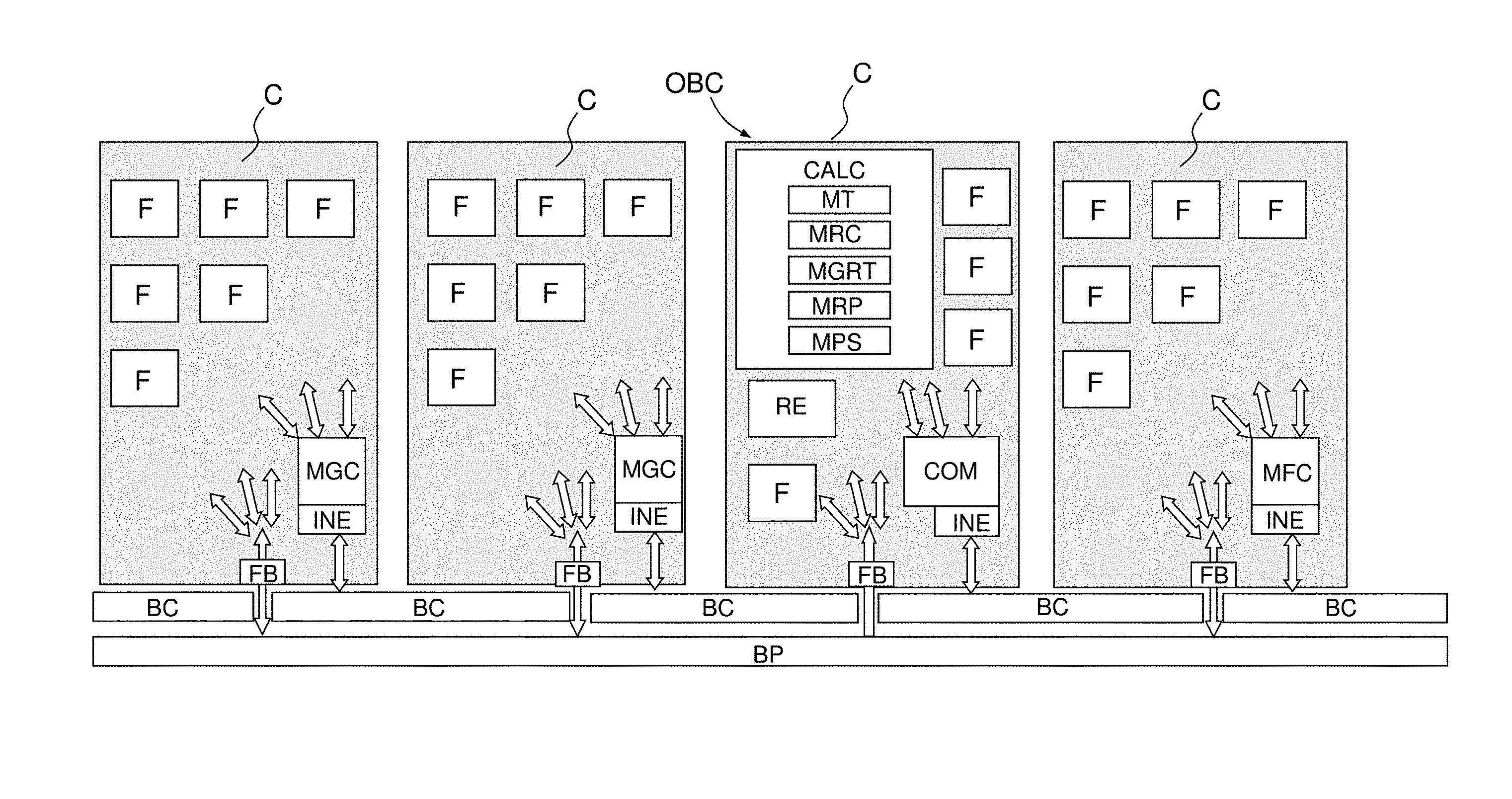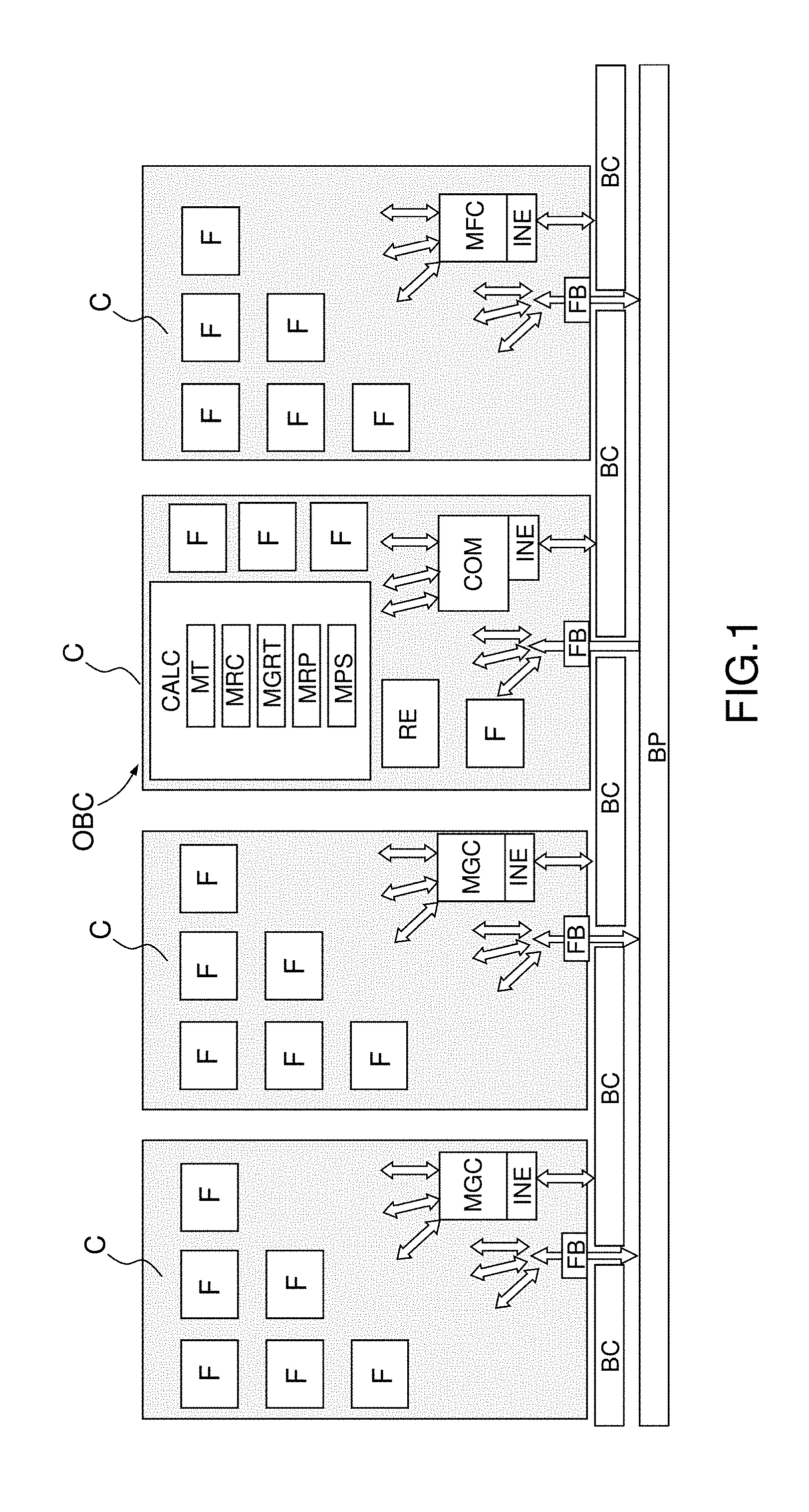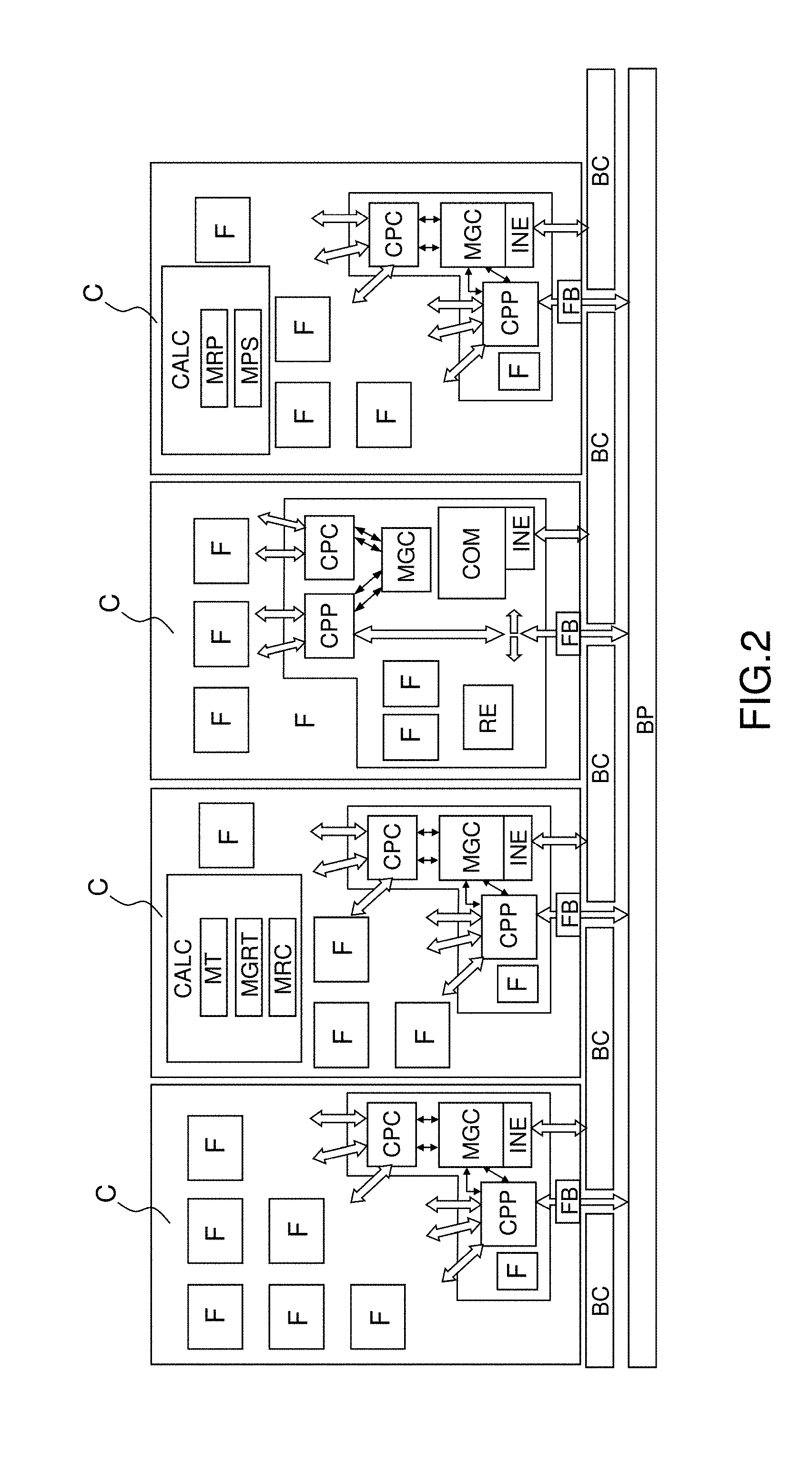Device For A Spacecraft
FOSSION; Marc ; et al.
U.S. patent application number 16/119521 was filed with the patent office on 2019-03-07 for device for a spacecraft. The applicant listed for this patent is THALES. Invention is credited to Marc FOSSION, Christophe MAILLARD.
| Application Number | 20190073325 16/119521 |
| Document ID | / |
| Family ID | 60574486 |
| Filed Date | 2019-03-07 |



| United States Patent Application | 20190073325 |
| Kind Code | A1 |
| FOSSION; Marc ; et al. | March 7, 2019 |
DEVICE FOR A SPACECRAFT
Abstract
A device for a spacecraft includes electronic boards; elements that are robust to radiation, i.e. that have a foreseeable failure rate that is lower than a threshold called acceptable threshold, comprising: a shared bus for exchanging electric power between electronic boards; a shared bus for exchanging data between the electronic boards; a module for managing the inputs/outputs and for telemetry gathering, per electronic board; an electrical level interface between an electronic board and the shared data exchange bus, per electronic board; wherein at least one electronic board comprises: a part equipped with COTS components whose failure rate is unforeseeable or greater than or equal to the acceptable threshold; and a firewall formed of components that are robust to radiation and whose failure rate is foreseeable and lower than the acceptable threshold, comprising a module for monitoring and protecting the power flows of the shared power exchange bus and a module for monitoring and protecting the inputs/outputs in order to manage the power supply and the communication of the components of the electronic board.
| Inventors: | FOSSION; Marc; (LIGNY, BE) ; MAILLARD; Christophe; (GESVES, BE) | ||||||||||
| Applicant: |
|
||||||||||
|---|---|---|---|---|---|---|---|---|---|---|---|
| Family ID: | 60574486 | ||||||||||
| Appl. No.: | 16/119521 | ||||||||||
| Filed: | August 31, 2018 |
| Current U.S. Class: | 1/1 |
| Current CPC Class: | B64G 1/428 20130101; B64G 1/66 20130101; G06F 13/20 20130101; B64G 1/546 20130101; G05B 19/0425 20130101; H02J 4/00 20130101; H04L 63/029 20130101; G05B 19/0428 20130101 |
| International Class: | G06F 13/20 20060101 G06F013/20; H04L 29/06 20060101 H04L029/06; H02J 4/00 20060101 H02J004/00; B64G 1/66 20060101 B64G001/66 |
Foreign Application Data
| Date | Code | Application Number |
|---|---|---|
| Sep 5, 2017 | EP | 17306147.4 |
Claims
1. A device for a spacecraft comprising: electronic boards; elements that are robust to radiation, i.e. that have a foreseeable failure rate that is lower than a threshold called acceptable threshold, comprising: a shared bus for exchanging electric power between electronic boards; a shared bus for exchanging data between the electronic boards; a module for managing the inputs/outputs and for telemetry gathering, per electronic board; an electrical level interface between an electronic board and the shared data exchange bus, per electronic board; wherein at least one electronic board comprises: a part equipped with COTS components whose failure rate is unforeseeable or greater than or equal to the acceptable threshold; and a firewall formed of components that are robust to radiation and whose failure rate is foreseeable and lower than the acceptable threshold, comprising a module for monitoring and protecting the power flows of the shared power exchange bus and a module for monitoring and protecting the inputs/outputs in order to manage the power supply and the communication of the components of the electronic board.
2. The device according to claim 1, wherein the shared electric power exchange bus is redundant.
3. The device according to claim 1, wherein the shared data exchange bus is redundant.
4. The device according to claim 1, comprising an on-board computer equipped with a calculator part, with a communication management part and with a redundancy and reconfiguration management part, the calculator part comprising COTS components whose failure rate is unforeseeable or greater than or equal to the acceptable threshold, and the communication management and redundancy and reconfiguration management parts being formed of components that are robust to radiation and whose fault rate is foreseeable and lower than the acceptable threshold.
5. The device according to claim 1, wherein the threshold is ten times lower than the intrinsic fault rate of the components.
6. A spacecraft equipped with a device according to claim 1.
Description
CROSS-REFERENCE TO RELATED APPLICATIONS
[0001] This application claims priority to foreign European patent application No. EP 17306147.4, filed on Sep. 5, 2017, the disclosure of which is incorporated by reference in its entirety.
FIELD OF THE INVENTION
[0002] The invention relates to a device for a spacecraft.
BACKGROUND
[0003] In the space sector, use is generally made of numerous electronic components said to be radiation-hardened, or in other words that have a failure rate due to radiation that is completely foreseeable and lower than a threshold, called acceptable threshold, which is generally ten times lower than the fault rate.
[0004] Failure rate due to radiation that is completely foreseeable is understood to mean a failure rate that is able to be proven by tests and calculations.
[0005] The cost of these components that are specifically designed to be robust or hardened to the effects of radiation is very high, and it is thus increasingly being contemplated to use COTS or `commercial off the shelf` components with a significantly lower cost. These components that are not specifically designed to operate in the presence of radiation originate from pre-existing land vehicle or military applications, hence the name COTS. They are characterized by a failure rate due to radiation that is unforeseeable or greater than the acceptable threshold. Specifically, an increasingly large amount of pressure is being placed on recurring costs of space devices, and particularly for components used to implement applications implemented by constellations of satellites.
[0006] For electronic components that are present in a large number, it is therefore highly beneficial in an economic sense to use COTS components while subjecting them to an array of additional tests.
[0007] The active electronic components (allowing the power of a signal to be increased) known as COTS are not designed for the purpose of withstanding the effects of ionizing radiation, while the majority of passive electronic components known as COTS (not allowing the power of a signal to be increased) are capable of resisting high-radiation space environments.
SUMMARY OF THE INVENTION
[0008] The present invention aims to mitigate the abovementioned drawbacks, and in particular the problem of tolerance to failures without impacting the performance of the spacecraft, while at the same time using components known as COTS, significantly limiting production costs.
[0009] According to one aspect of the invention, what is proposed is a device for a spacecraft comprising: [0010] electronic boards [0011] elements that are robust to radiation, i.e. that have a foreseeable failure rate that is lower than a threshold called acceptable threshold, comprising: [0012] a shared bus for exchanging electric power between electronic boards; [0013] a shared bus for exchanging data between the electronic boards; [0014] a module for managing the inputs/outputs and for telemetry gathering, per electronic board; [0015] an electrical level interface between an electronic board and the shared data exchange bus, per electronic board; [0016] wherein at least one electronic board comprises: [0017] a part equipped with COTS components whose failure rate is unforeseeable or greater than or equal to the acceptable threshold; and [0018] a firewall formed of components that are robust to radiation and whose failure rate is foreseeable and lower than the acceptable threshold, comprising a module for monitoring and protecting the power flows of the shared power exchange bus and a module for monitoring and protecting the inputs/outputs in order to manage the power supply and the communication of the components of the electronic board.
[0019] Such a device makes it possible to be able to manage the problem of tolerance to faults without impacting performance, while using components known as COTS, significantly limiting production costs.
[0020] In one embodiment, the shared electric power exchange bus is redundant.
[0021] Thus, in the event of a fault with the shared electric power exchange bus, the redundant shared electric power exchange bus takes over.
[0022] According to one embodiment, the shared data exchange bus is redundant.
[0023] Thus, in the event of a fault with the shared data exchange bus, the redundant shared data exchange bus takes over.
[0024] In one embodiment, the device comprises an on-board computer equipped with a calculator part, with a communication management part and with a redundancy and reconfiguration management part, the calculator part comprising COTS components whose failure rate is unforeseeable or greater than or equal to the acceptable threshold, and the communication management and redundancy and reconfiguration management parts being formed of components that are robust to radiation and whose failure rate is foreseeable and lower than the acceptable threshold.
[0025] The number of radiation-hardened components, and therefore the cost of the device, is thus limited. The performance (increase in available calculating power and reduction of electricity consumption) is improved.
[0026] In one embodiment, the acceptable threshold is ten times lower than the intrinsic fault rate of the components.
[0027] According to another aspect of the invention, what is also proposed is a spacecraft equipped with a device such as described above.
BRIEF DESCRIPTION OF THE DRAWINGS
[0028] The invention will be better understood on studying a few embodiments described by way of completely non-limiting example and illustrated by the appended drawings, in which:
[0029] FIG. 1 schematically illustrates a device for a spacecraft according to the prior art; and
[0030] FIG. 2 schematically illustrates a device for a spacecraft according to one aspect of the invention.
[0031] In the various figures, elements that have identical references are identical.
DETAILED DESCRIPTION
[0032] In FIG. 1, a device from the prior art comprises a plurality of electronic boards C, four electronic boards in this case, all comprising exclusively radiation-hardened components, i.e. that have a fault rate that is foreseeable and lower than a threshold.
[0033] All of them comprise components that perform various conventional avionic functions F.
[0034] The device also comprises a shared bus BP for exchanging electric power between the electronic boards C, and a shared bus BC for exchanging data between the electronic boards C.
[0035] The buses BP and BC are generally redundant, so as to take over in the event of a fault.
[0036] One of the electronic boards C comprises the components that form the on-board computer OBC. The on-board computer OBC comprises a calculator part CALC, a communication management part COM, and a redundancy and reconfiguration management part RE.
[0037] The calculator part CALC comprises, as is conventional, a trajectography module MT, a module MRC for regulating the loading of the batteries of the spacecraft, a thermal regulation management module MGRT, a GNSS positioning receiver module MRP, and a stellar pointer module MPS.
[0038] A fuse FB is positioned between the shared electric power exchange bus BP and each electronic board C in order to disconnect an electronic board C that may be defective from the shared electric power exchange bus BP, so as not to propagate this defect.
[0039] Each electronic board C comprises an electrical level interface INE between the board and the shared data exchange bus, per electronic board C. This interface INE makes it possible to adjust the electrical levels, which are generally different on the electronic board and on the shared data exchange bus BC (such as a CAN transceiver).
[0040] Furthermore, each electronic board C, except for the board comprising the on-board computer OBC, comprises a module MGC for remotely managing the inputs/outputs and for telemetry gathering. The board comprising the on-board computer OBC does not comprise a module MGC for managing the inputs/outputs and for telemetry gathering, as it is this module that pools the information coming from the other electronic boards. By contrast, it has to ensure the management and the correct operation of the shared data exchange bus BC.
[0041] Such a device is expensive, as it requires the use of electronic boards equipped exclusively with components that are robust to radiation and radiation-hardened.
[0042] FIG. 2 shows a device for a spacecraft according to one aspect of the invention.
[0043] The device comprises electronic boards C, four electronic boards in this case, comprising radiation-hardened components and non-radiation-hardened components.
[0044] All of them comprise components that perform various conventional avionic functions F.
[0045] The device also comprises a shared bus BP for exchanging electric power between the electronic boards C, and a shared bus BC for exchanging data between the electronic boards C.
[0046] The buses BP and BC are generally redundant, so as to take over in the event of a fault.
[0047] The electronic boards C comprise the components that form the on-board computer OBC. The on-board computer OBC comprises a calculator part CALC, a communication management part COM, and a redundancy and reconfiguration management part RE.
[0048] The communication management part COM and the redundancy and reconfiguration management part RE are formed of elements that are robust to radiation or radiation-hardened, and the calculator part CALC comprises components that are not robust to radiation.
[0049] The calculator part CALC comprises, as is conventional, a trajectography module MT, a module MRC for regulating the loading of the batteries of the spacecraft, a thermal regulation management module MGRT, a GNSS positioning receiver module MRP, and a stellar pointer module MPS. These modules of the calculator part CALC may be distributed over various electronic boards C, for example over two electronic boards in the present example.
[0050] A fuse FB is positioned between the shared electric power exchange bus BP and each electronic board C in order to disconnect a defective electronic board C from the shared electric power exchange bus BP and avoid propagating this defect.
[0051] Each electronic board C comprises an electrical level interface INE between the board and the shared data exchange bus, per electronic board C. This interface INE makes it possible to adjust the electrical levels, which are generally different on the electronic board C and on the shared data exchange bus BC (such as a CAN transceiver).
[0052] Furthermore, each electronic board C comprises a module MGC for managing the inputs/outputs and for telemetry gathering.
[0053] The modules MGC are formed of components that are robust to radiation.
[0054] All of the electronic boards C therefore comprise a module MGC for managing the inputs/outputs and for telemetry gathering, remotely or not remotely.
[0055] Each electronic board C comprises a firewall formed of components that are robust to radiation, comprising a module CPP for monitoring and protecting the power flows of the shared power exchange bus and a module CPC for monitoring and protecting the inputs/outputs in order to manage the power supply and the communication of the components of the electronic board.
[0056] A module CPP for monitoring and protecting the power flows of the shared power exchange bus makes it possible to control and monitor power consumption dynamically and to check that it actually corresponds to the tasks being executed by the electronic components present on the electronic board. In the event of a mismatch, the occurrence of a failure due to radiation is concluded therefrom.
[0057] A module CPC for monitoring and protecting the inputs/outputs in order to manage the power supply and the communication of the components of the electronic board makes it possible to control and monitor the flows of information that enter and leave electronic boards C. In the event of an abnormally high or low volume of traffic, or if the content is abnormal/incoherent, the occurrence of a failure due to radiation is concluded therefrom.
[0058] It is therefore possible to furnish a spacecraft equipped with a device as described above.
[0059] Such a device therefore makes it possible to use non-radiation-hardened components in spacecraft, thereby making it possible to use off the shelf components that are far more powerful or efficient than those that are conventionally radiation-hardened, and to drastically reduce the cost of such a device, while at the same time complying with the constraints in terms of availability of the service provided by aerospace devices.
* * * * *
D00000

D00001

D00002

XML
uspto.report is an independent third-party trademark research tool that is not affiliated, endorsed, or sponsored by the United States Patent and Trademark Office (USPTO) or any other governmental organization. The information provided by uspto.report is based on publicly available data at the time of writing and is intended for informational purposes only.
While we strive to provide accurate and up-to-date information, we do not guarantee the accuracy, completeness, reliability, or suitability of the information displayed on this site. The use of this site is at your own risk. Any reliance you place on such information is therefore strictly at your own risk.
All official trademark data, including owner information, should be verified by visiting the official USPTO website at www.uspto.gov. This site is not intended to replace professional legal advice and should not be used as a substitute for consulting with a legal professional who is knowledgeable about trademark law.